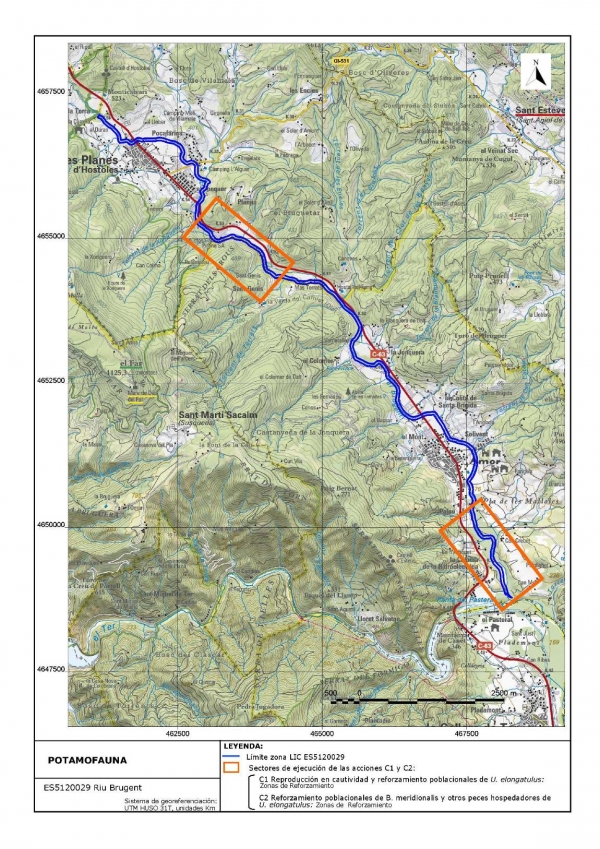Brugent River
Surface: 68.300 ha.
The Natura 2000 area Brugent River (ES5120029) has good condition with a significant role as a biological corridor between the Garrotxa Volcanic Zone (ES5120004) and the lower part of the river Ter (ES5120011). Brugent is a river part of La Selva and the Garrotxa regions and is a tributary of the River Ter by its left side. The basin extends primarily by the municipalities of Sant Feliu de Pallerols, Les Planes and Amer and is framed between the mountains of the Oriental Collsacabra and the western slope of the MedesMountains and the cliffs of San Roc. As a tributary, is notable for being the first to lead the River Ter in its lower course and it is one of the most important water supply.
The working area of the project does not include all of the SCI space, but a big part in this space was eminently riparian. Here the project area focuses only on streams and rivers, involving an area centered around these environments in which they live aquatic species objective of the project.
The Naiad Unio elongatulus. Its regression in Catalan Basins has been dramatic. The population of this species existing in the Brugent River is one of the few well preserved ones, and in the whole basin of northeastern Catalonia. In the Brugent River there is a single population of Unio elongatulus, located in a section with a shape similar to a water channel with slow and uniform course. Within the river basin of the River Ter, this is one of the populations situated further upstream, and better condition, although there is insufficient data.
Some actions are planned such as stocking with captive-bred breeding laboratory naiads in Consorci de l’Estany from parental individuals of the same river basin. Since there may be some genetic differentiation between basins and sub-basins, the units used must come from production lines based on the same parental space or spaces next within the same watershed (BrugentRiver). In each of these areas between 2 and 4 sectors will be chosen, where reinforcements will be conducted with youth naiads and infestations of wild fish with naiads. These sectors will be allocated based on information previously available on the general state of the rivers in the area of general scope of the project and the current understanding of the requirements of the species and the status of their populations. Chosen stretches of river with a stable river channel morphology, suitable courses, good water quality, scarce natural hydrological stress, general good ecological status and the presence of at least one species of native fish host, among other criteria.
Noted that in the area have not yet been identified as species Dreissena polymorpha and Corbicula fluminea, but it has been found Anodonta woodiana an invasive bivalve. The threat of these species in the wetlands of Catalonia is very high, even in stagnant water bodies such as lakes and marshes.
Mediterranean Barbel (Barbus meridionalis). This species is experiencing a gradual decline in the whole small distribution area, located in southern Europe. While still maintaining stable populations in dense areas or in some rivers, it has disappeared from many sectors, especially along the main river zones where has previously occupied. In the basin of Brugent River, Barbus meridionalis still holds stable populations, but is generally in decline, having disappeared completely from the middle-bottom of the river. The recovery actions for Barbus meridionalis in Brugent River depend on the relationship with stock recovery Unio elongatulus. In places where it is intended to repopulate youth Unio elongatulus bred in captivity, studied the composition of fish, to ensure the presence of the guests for naiads such as Barbus meridionalis, Squalius laietanus or Salaria fluviatilis. In case of not having the presence of these species, reforestation run occasionally with Barbus meridionalis.

















